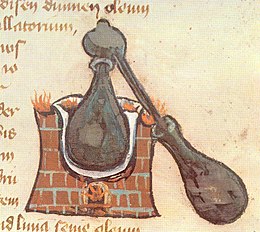Analembic(fromArabic:الإنبيق,romanized:al-inbīq,originating fromAncient Greek:ἄμβιξ,romanized:ambix,'cup, beaker')[1][2][3]is analchemicalstillconsisting of two vessels connected by a tube, used fordistillationof liquids.

Description
editThe complete distilling apparatus consists of three parts:
- the "cucurbit"(Arabic:ḳarʿa;Greek:βῖκος,bîkos), the still pot containing the liquid to be distilled, which is heated by a flame
- the "head" or "cap" (إِنْبِيق,ʾinbīq;Greekἄμβιξ,ambix) which fits over the mouth of the cucurbit to receive the vapors, with an attached downward-sloping "tube" (σωλήν,sōlēn)
- the "receiver" (قَابِلَة,qābila;ἄγγος,angosorφιάλη,phialē) container
In the case of another distilling vessel, theretort,the "cap" and the "cucurbit" have been combined to form a single vessel. The anbik[4] is also called theraʾs(the Arabic wordraʾsmeans "head" ) of the cucurbit. The liquid in the cucurbit is heated or boiled; the vapour rises into theanbik,where it cools by contact with the walls and condenses, running down the spout into the receiver. A modern descendant of the alembic is thepot still,used to producedistilled beverages.
History
editDioscorides's ambix, described in hisDe materia medica(c. 50 C.E.), is a helmet-shaped lid for gathering condensed mercury. ForAthenaeus(c. 225 C.E.) it is a bottle or flask. For later chemists it denoted various parts of crude distillation devices.
Alembic drawings appear in works ofCleopatra the Alchemist(3rd century C.E.),Zosimos of Panopolis(c. 300 C.E.), andSynesius(c. 373 – c. 414 C.E.). There were alembics with two (dibikos) and three (tribikos) receivers.[5]According to Zosimos of Panopolis, the alembic was invented byMary the Jewess.[6]
The anbik is described byIbn al-Awwamin hisKitab al-Filaha(Book of Agriculture), where he explains howrose-wateris distilled. Amongst others, it is mentioned in theMafatih al-Ulum(Key of Sciences) ofKhwarizmiand theKitab al-Asrar(Book of Secrets) ofal-Razi.Some illustrations occur in the Latin translations of works which are attributed toGeber.[2]
-
Alembic ofZosimos of Panopolis
-
Modern alembic
-
Large "charentais" type alembic for distilling spirits
-
Copperretort
-
Glass alembic
-
Alembic metalwork in the staircase at the Chemical Faculty ofGdańsk University of Technology,1904
Unicode
editTheUnicode character setspecifies three symbols for alembics: thepictogram⚗ (U+2697), itsemojivariation ⚗️ (U+2697U+FE0F), and the ancient alchemical symbol 🝪 (U+1F76A).
See also
editReferences
edit- ^M. Ullmann (1986), "AL-KĪMIYĀ",The Encyclopaedia of Islam,vol. 5 (2nd ed.), Brill, p. 111b,ISBN90-04-07819-3
- ^abE. Wiedemann;M. Plessner (1986), "AL-ANBĪḲ",The Encyclopaedia of Islam,vol. 1 (2nd ed.), Brill, p. 486a,ISBN90-04-08114-3
- ^Henry Liddell;Robert Scott,eds. (1897), "ἄμβιξ",A Greek–English Lexicon(8th ed.), Harper & Brothers, p. 73
- ^ The complete distilling apparatus consists of three parts: the "cucurbit" (ḳarʿa), the "head" or "cap" (anbīḳ) and the "receiver" (ḳābila).
- ^Marcellin Berthelot(1889),Introduction à l'étude de la chimie des anciens et du moyen âge,Steinheil, pp. 132, 135–142, 161–16
- ^Edmund Lippmann(1919),Entstehung und Ausbreitung der Alchemie,Springer, pp. 48–49
External links
edit- The dictionary definition ofalembicat Wiktionary